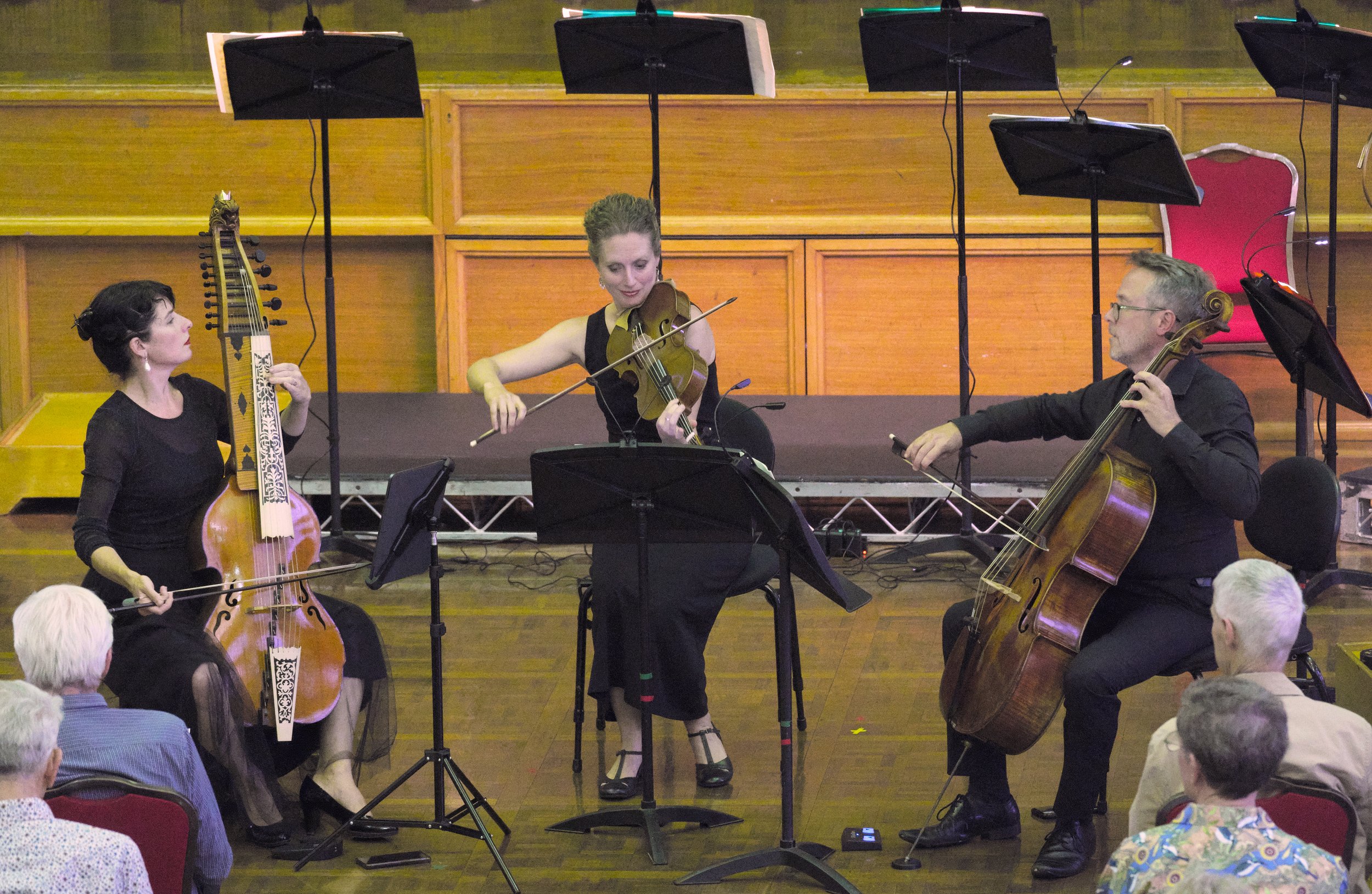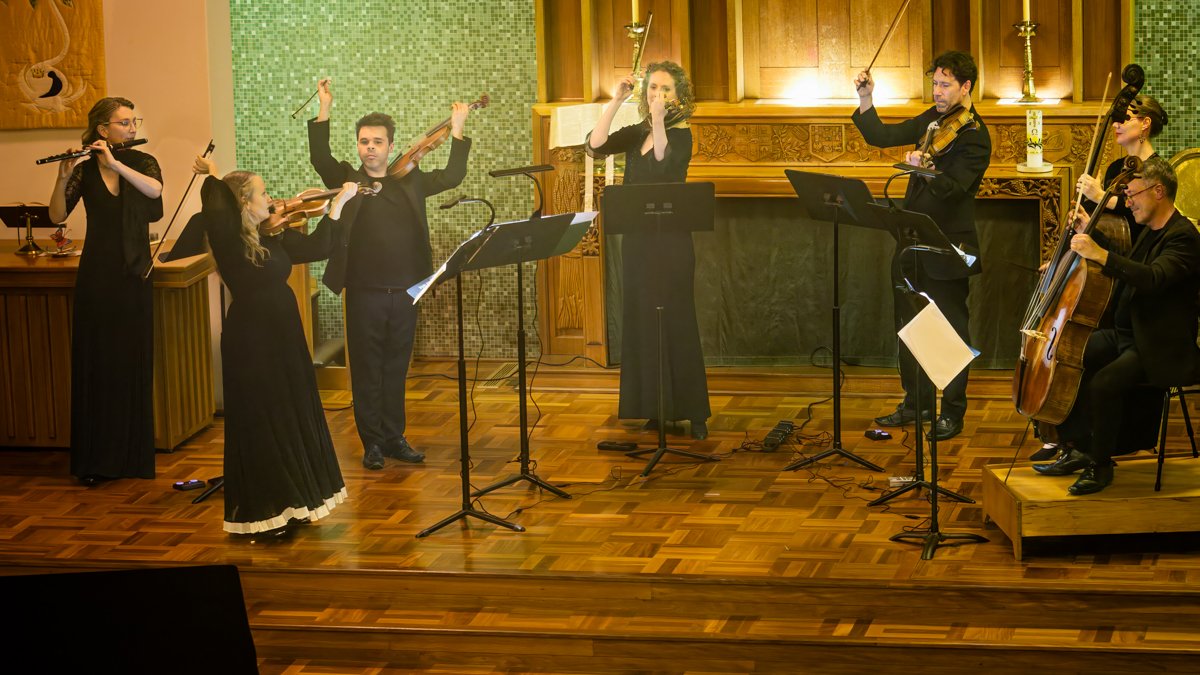HAYDN'S TIMES OF DAY | Limelight
★★★★ “…made for a refreshingly light and airy programme led by Artistic Director Skye McIntosh to close the AHE’s 12th season – a year which has seen it undertake its first US tour, playing the Carnegie Hall in New York and at the opening of Australia’s new embassy in Washington DC.”
Steve Moffat | Limelight | Australia | 17 December 2023
HAYDN'S TIMES OF DAY | SOUNDS LIKE SYDNEY
“…all credit to McIntosh not only for her direction but for her solo work as well.”
“The AHE, elegantly presented in long black concert dress, played with collective excellence…”
Shamishta da Soysa | Sounds Like Sydney | NSW | 16 December 2023
HAYDN'S TIMES OF DAY | STATE OF THE ARTS
★ ★ ★ ★ “ It features prominently Skye Mcintosh on violin, who negotiated the rhetorical flourishes with great effect and gave to it a song-like quality.”
Aryan Mohseni | State of the Art | NSW | 16 December 2023
AHE - HAYDN’S TIMES OF DAY
★ ★ ★ ★
It is reputed that Prince Paul Anton von Esterhazy was fond of programmatic music. But most pieces we now consider programmatic were given their names only after they were conceived. Not so with Haydn’s so-called Times of Day symphonies.
Thee first symphony is Symphony No 6 in D major, later dubbed Le Matin (Morning). It begins sotto voce, as though anticipating a spectacular opening. Melissa Farrow emerges with a delightful theme on flute that is redolent of birdsong. The entire Allegro section lulls between loud and soft, busy and sparse. In the second movement we see the clearest expression of the morning theme – a rising sun depicted on violin. All this goes to show that programmatic music was not the preserve of the Baroque.
But it seems that Haydn was inspired by what came before him. The symphonies seem an adaptation of the concerto grosso form of yesteryear, and the Adagio concludes with a solemn Corelliesque peroration. The Menuet, too, gives prominence to the bass voices. It is unusual for its time, but one has only to think of the bassoon solo in Bach’s Orchestral Suites. Here we have a whimsical duet between Daniel Yeadon on cello and Simon Rickard on bassoon, which takes some arabesque turns.
The symphony that follows, Le Midi, is just as youthful. It opens, quite unlike Le Matin, with a slow ceremonial march. But it soon breaks into a vibrant series of tremolos and running passages synchronised among the violins. But the highlight was the second movement, which opens with a “Recitative”. It is fittingly operatic, and almost Romantic, in style. It features prominently Skye Mcintosh on violin, who negotiated the rhetorical flourishes with great effect and gave to it a song-like quality. The persistence and agitation of the rhythm is reminiscent of CPE Bach’s so-called “Hamlet” piece for clavichord and of the empfindsamer stil more generally. But it soon moves from brooding to delightfully galant. The menuetto and trio features tortuous passages for the violone, which Lara Vaughan performed with great skill.
After the interval came Lara Vaughan introducing a very peculiar instrument called the baryton. Its closest relative is the viola da gamba, but it features various added ‘sympathetic’ strings and, remarkably, a set of strings behind the fretboard which the player plucks to give an effect that is something like a sitar or harpsichord. Haydn composed 175 compositions for the baryton. And with the Baryton Trio No 70 in G major, one can soon see why. The first few notes were given to the baryton, which had a mellow and earthy timbre, much like the viola da gamba. Part of the motif was a series of consecutive notes for the plucked strings. It is a wonder how Vaughan could so deftly switch between the two. But altogether, although it is a perfectly agreeable piece, it is not particularly captivating.
The Divertimento a 8 voci No 1 in D major also features the baryton. It was designed skilfully by Haydn to accommodate the Prince’s then-fledgling skills on the baryton. But it is not just the baryton that shines here. Matthew Greco assumes centre-stages as the first violin takes something of a continuo role.
The Symphony No 8 in G major is Le Soir – Night. The first movement has a rustic sense to it, being a gigue in sonata form, and quotes a melody from a song in Gluck's Le diable à quatre – "Je n'aimais pas le tabac beaucoup" ("I didn't like tobacco much"). It also features a captivating and rapidly-modulating series of tremolos. The highlight is the finale, a Presto, where light interruptions by Farrow on the flute and Yeadon on cello cut through the business of the strings.
HAYDN'S TIMES OF DAY | CANBERRA
“In its first concert series since returning from touring America and its New York debut at Carnegie Hall, the Australian Haydn Ensemble (AHE) showed why it is so popular across the world.”
Rob Kennedy | Canberra City News | ACT | 16 December 2023
AHE US TOUR WASHINGTON CLASSICAL REVIEW
“…Le Matin” was rendered beautifully with a lush blend in the strings. McIntosh brought a sense of spontaneity and excitement to the solo violin passages…”
Alex Baker | Washington Classical Review | Columbia MD | 20 October 2023
AHE US TOUR CARNEGIE HALL | NY CONCERT REVIEW
“…an extended standing ovation. … the Australian Haydn Ensemble is not to be missed”
Jeffrey Williams | New York Concert Review | New York | 18 October 2023
AHE US TOUR CARNEGIE HALL blogcritics New York
“Superb ensemble playing.”
Jon Sobel | blogcritics | New York | 17 October 2023
AHE US TOUR CARNEGIE HALL
“Australian Haydn Ensemble joy and expertise. This is their first American presence. Let it not be the end.”
Harry Rolnick | Concert On Net, New York | 17 October 2023
BEETHOVEN'S SEVENTH | State of the Art | SYDNEY
★★★★1/2 “A celebration of what the Australian Haydn Ensemble does best ”
Aryan Mohseni | State of the Art | 22 August 2023
BEETHOVEN'S SEVENTH | Canberra
“…had the audience on their feet at the end with hooting and hollering and stamping of feet in appreciation.”
Graham McDonald | Canberra City News | 18 August 2023
DIE STILLE NACHT | Sydney Arts Guide
★★★★1/2 “.The program is so beautifully curated, interesting throughout and a great showcase for the artists”
Annabelle Drumm, State of the Art, 21 June 2023
DIE STILLE NACHT | Australian Stage
“To hear Melissa Farrow perform this was to listen to a masterclass in extreme subtlety of expression…
Australian Stage, 22 June 2023
DIE STILLE NACHT | Limelight
★★★★1/2 “.Led by Artistic Director Skye McIntosh, the six members of the Ensemble were in sparkling form for a programme that both moved and uplifted in equal measure. And if Greco was the star of the show, his co-star was undoubtedly Melissa Farrow”
Steve Moffat, Limelight, 21 June 2023
Die Stille Nacht | Sounds Like Sydney
“The combination of the two was magical, with the ensemble as ever, performing with verve and style.”
The Mozarts, The Haydns & The Bear | ClassikON
“The Australian Haydn Ensemble is clearly a treasure…”
By Alan Holley, ClassikON
The Mozarts, The Haydns & The Bear | State of the Art
★★★★1/2“…The orchestra performed the first movement at a spectacularly lively tempo, under Roland Peelman’s equally-lively direction.” Aryan Mohseni, State of the Art
The Mozarts, The Haydns & The Bear | Sounds Like Sydney
“Classy and clever entertainment which drew threads through and along generations, connecting father with son and brother with brother.” Shamistha de Soysa, Sounds Like Sydney
The Mozarts, The Haydns & The Bear | Limelight
★★★★1/2 “Even when heard from the very last row in the Fitters’ Workshop, AHE created a spectacular sound.”
Rob Kennedy, Limelight, 29 April 2023
The Mozarts, The Haydns & The Bear | Canberra City News
“The musical highlight was undoubtedly a masterful performance of Franz Joseph Haydn’s “Symphony No 82 in C major.”
Helen Musa, Canberra City News 29 April 2023
Haydn's Sun & Mendelssohn's Stars | Sydney | Limelight
★★★★“This was superlative playing of what must be music in its purest form.…”
Steve Moffat, Limelight, 21 Feb 2023












